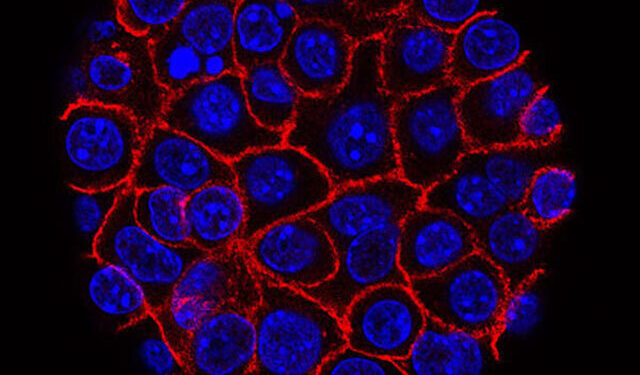Pancreatic cancer cells (blue) growing as a sphere wrapped in membranes (red). Credit: National Cancer Institute
Italian scientists from the Cattolica University of Rome have discovered an important genetic mechanism that pancreatic cancer cells use to evade therapies, paving the way for new drugs against a deadly disease. The tumor escapes treatment by implementing a “favorable genetic rearrangement”, strategically playing its best cards to thwart cures.
This discovery is the result of a study published in the journal Cell Reports Medicinecoordinated by Claudio Sette, professor of human anatomy at the Catholic University and director of the organoids facility at the Policlinico Universitario A. Gemelli IRCCS.
“We discovered a mechanism based on the regulation of messenger RNAs that contributes to chemotherapy resistance,” explains Sette. “There are already drugs targeting RNA, used in other medical indications, to counteract this type of regulation. These drugs could potentially be developed as anti-tumor agents for resistant patients.”
Pancreatic cancer affects approximately 500,000 people worldwide each year. Although it is the 14th most common cancer in terms of incidence, it is unfortunately today the seventh leading cause of cancer death. The five-year survival rate is less than 10%, mainly limited to patients eligible for surgery (approximately 20-30% of the total).
When the genetic code is transcribed into RNA for protein synthesis, “alternative splicing” can occur. This means that different transcripts can be produced from the same gene, depending on which genetic “cards” (exons, the part of the gene coding for amino acids in proteins) are selected to be “played.” Splicing leads to the production of various proteins playing different roles through the alternative assortment of exons from the original gene. Splicing is commonly impaired in tumors, including pancreatic cancer.
“By comparing pancreatic tumors of different subtypes,” explains Professor Sette, “we observed that therapy-resistant cancer is associated with specific splicing regulation, leading to the synthesis of proteins associated with resistance to chemotherapy. Our study… also identified a splicing regulator called “Quaking” that is expressed in more aggressive pancreatic tumors and promotes the synthesis of proteins conferring chemoresistance.
There are already splicing-regulating drugs that could potentially be used for this type of cancer; including therapies for individual splicing events, such as the drug nusinersen which is currently used in spinal muscular atrophy.
“Our discovery opens up new treatment possibilities for a type of tumor that generally does not respond to existing therapies,” concludes the professor.
More information:
Alternative splicing signature defines basal-like phenotype and predicts worse clinical outcomes in pancreatic cancer, Cell Reports Medicine (2024). DOI: 10.1016/j.xcrm.2024.101411. www.cell.com/cell-reports-medi … 2666-3791(24)00034-X
Provided by the Catholic University of the Sacred Heart
Quote: Italian scientists reveal a resistance mechanism used by pancreatic cancer cells to escape therapies (February 6, 2024) retrieved February 6, 2024 from
This document is subject to copyright. Apart from fair use for private study or research purposes, no part may be reproduced without written permission. The content is provided for information only.



